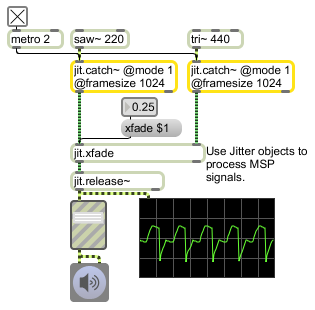| Name |
Type |
g/s |
Description |
| mode |
int |
|
Four different modes are possible: in mode 0, all data since the last output is output in a one-dimensional matrix. In mode 1 the amount of buffered data that fits into a multiple of the framesize is output in two dimensions; data not output will be saved for the next time. In these first two modes, every sample collected should be output once and only once. In mode 2 a framesize of the most recent data is output. Mode 3 causes jit.catch~ to behave like an oscilloscope, triggering on channel trigchan when the signal crosses triglevel in the direction trigdir. If the threshold has not been passed for the duration of the entire internal data buffer (100 ms), jit.catch~ reverts temporarily to mode 2 behaviour and outputs the most recent data until the threshold is crossed again. |
| framesize |
int |
|
In some modes, the width of the output matrix. (default=320) |
| trigthresh |
float |
|
The signal level at which to trigger a redraw in mode 3 (default=0.0) |
| trigdir |
int |
|
The direction to use to identify crosses in the trigger point: 0 is upwards, and 1 is downwards. (default=0) |
| trigchan |
int |
|
In mode 3, the channel to use for trigger points (default=0) |
| downsample |
int |
|
A downsampling factor (default=1). If downsampling value is set to n, each group of n successive samples are averaged. |

